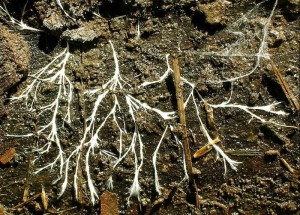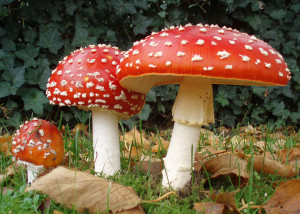 Just like humans, plants have a social network, or web, that they use to communicate with each other. There is literally a fungal internet in which information-carrying chemicals travel through the network to other plants. The information sent is used to help the other plants connected to the network cope with insect attacks, pathogens, and drought stress.
Just like humans, plants have a social network, or web, that they use to communicate with each other. There is literally a fungal internet in which information-carrying chemicals travel through the network to other plants. The information sent is used to help the other plants connected to the network cope with insect attacks, pathogens, and drought stress.
The source of this underground network of communication is mycorrhizal fungi. Mycorrhizae is a thread-like fungus that grows underground, producing strands called mycelia, fine filaments that connect one set of roots to another. Plants connected to the network get advance warnings of attacks and are able to activate their chemical defense systems. Those not connected to the fungal network do not get the message to activate their defense systems. This is all supported by recent scientific evidence.
But that’s not all the mycorrhizae fungi do. These beneficial soil microorganisms are also known to promote overall plant growth. The do this through a symbiotic relationship with the plants: mycorrhizae help with the plant’s nutrient uptake, in exchange for sugars the plant produces. Many plants could not survive without this important relationship. 
There are two main types of mycorrhizae – ecto and endo (also known as abuscular mycorrhizae). Ecto-mycorrhizae are mostly associated with trees. They work with trees by attaching themselves to the trees’ woody roots and forming an external sheath around the root. These are also the type of fungi that form the fruiting bodies you see above ground, better known as mushrooms. All mushrooms are the fruiting bodies of mycorrhizal fungi.
 Endo-mycorrhizae are associated with most other plants, including vegetables (though not brassicas), grasses, fruits, most shrubs, and, small fruiting trees, like pears, apples and plums. They work with the plant by entering the cells of the host plant and forming spores inside the roots and surrounding soil, usually in response to some form of stress. This form of mycorrhizae does not fruit above ground. They are asexual, and cannot easily repopulate an area from which they have been depleted, and therefore need a little help from us at times with an inoculation.
Endo-mycorrhizae are associated with most other plants, including vegetables (though not brassicas), grasses, fruits, most shrubs, and, small fruiting trees, like pears, apples and plums. They work with the plant by entering the cells of the host plant and forming spores inside the roots and surrounding soil, usually in response to some form of stress. This form of mycorrhizae does not fruit above ground. They are asexual, and cannot easily repopulate an area from which they have been depleted, and therefore need a little help from us at times with an inoculation.
Most mycorrhizae are not capable of living without a host plant. The spores they produce will normally lay dormant in the soil until they find another host.
Another way that mycorrhizae helps plants is by aiding the plant in gathering nutrients from a larger area of the soil they’re planted in, using the many filaments of fine mycelia the fungi produces. This can expand the plant’s feeding area anywhere from 10 – 1000 times.
Plantings inoculated with mycorrhizal fungi suffer less from stress caused by heat, drought, and transplant shock than those without it.
Mycorrhizal fungi are also essential in breaking down hard-to-capture nutrients like phosphorus and iron so that the plant can take them up. Other ways they help the host plant are by:
• Protecting the plant from root-feeding nematodes
• Protecting the plant from pathogenic fungi and bacteria
• Dispersing an oversupply of nutrients to a broader area
So how do we encourage mycorrhizae in the garden?
Generally, most soils that we start with are depleted of mycorrhizal fungi through soil compaction, chemicals, tilling, etc. To get started:
• First, we have to reintroduce mycorrhizae to the soil with an inoculation.
• Second, we have to have plants for it to work with.
• Third, we must not disturb the soil, through tilling or excessive shoveling. When we do this, we break and destroy the web of filaments that connects everything.
• Fourth, in line with the above, don’t pull your vegetables out by the roots. Cut them off and leave the roots to die and break down naturally in the soil. This will give the fungi a chance to prepare and put out the spores necessary to reproduce, for the use of future plantings.
Mycorrhizae are an essential part of a good life support system. Like the veins in our bodies or the wires in an electrical system, they are the connections of life inside the earth.

Kyle says
Hi my name is Kyle and first I wanted to thank you for this article on mycorrhizae fungi though I do have a question in which I need asnswered as soon as possible in order to help me grow my watermelon. Now I’ve read a few articles on mycorrhizae but more so watermelon, from what I’ve read getting a watermelon to be at its sweetest there are steps and procedures that can be taken to help ensure this. While reading about watermelon and how to get its natural sweetness out I came across mycorrhizae, I believe I kind of understand the relationship between the two but there is one thing that gets me… Will having mycorrhizae take from the watermelons sweetness?! Seeing as how the plant gives the fungi its sugar wouldn’t that make the watermelon not as sweet as it potentially could be or am I missing something here? Thank you for time and I look forward to hearing back from you.
ashley says
Hi Kyle, we have not noticed a decrease in quality of the taste of the various plants we have grown with the addition of mycorrhizae. I also did some research and found a couple of papers specific to watermelons. Both studies indicated an increase in yield and water-use efficiency with added mycorrhizae, and one specifically indicated no loss in quality. I know that flavors in water-heavy fruits like watermelons and tomatoes depends a lot on both soil composition and particularly amount of water near harvest time. Sugars become diluted with more watering, so for sweeter melons it’s a good idea to cut back on watering a couple of weeks before harvest – just water to the point where vines aren’t wilting and that will help concentrate the sugars in the fruit.
Don says
This statement is incorrect – “All mushrooms are the fruiting bodies of mycorrhizal fungi.” There are many edible fungi that are not mycorrhizal, in fact the most popular commercially grown mushrooms are not mycorrhizal.
Expert Hiker says
You’re flat out wrong that all mushrooms are mycorrhizal. Flat out wrong.
Shitake grow on dead rotting wood. So do many others, many many others. Turkey tail, shoot I could probably bore you to death with listing them all.
Angela Stefanik says
Even mushrooms grown on rotting wood use micorrhizal connections inside the rotted wood. The wood needs to be innoculated with the spores, then the micorrhizae grows from the spores – INSIDE THE WOOD! Now, once the rotted wood is fully propogated with mycelia (sp?) , the fruit or “mushrooms” will grow on the surface, but the main mass of the mycelial growth- aka the parent plant- is underground or inside of the “ROTTING WOOD” that was mentioned as not being micorrhizal.. Don, Expert Hiker, how would a plant produce fruit without a mother plant??
Yudel says
Angela Stefanik, you’re confusing the terms mycelium and mycorrhizal. The mass of fungi you’re describing is called the mycelium. Yes, this grows within the rotting wood and the mushrooms sprout from it, but this doesn’t make these fungi mycorrhizal. Mycorrhizal fungi are a specific subset of fungi that form symbiotic relationships with living plants, as described in the article. They have mycelium below ground and reproductive mushrooms. Along with mycorrhizal fungi though, there are many species of fungi, many of which do produce mushrooms, that have other ways of making a living. Some are saprophytic, meaning they decompose dead plant material, and include mushrooms like the shiitake and Turkey tail. Others are pathogenic, meaning they break down cells of living plants, harming or killing them. These include the honey mushrooms or armillaria. So it is not at all true to say that all mushrooms are formed from mycorrhizal fungi. Many are. But many mushrooms are formed from saprophytic or pathogenic fungi. These fungi will also consist of threads below ground or within wood called mycelium, but the mycelium of these species will not be feeding nutrients to the plants they colonize or connect individual trees and other plants into a symbiotic network.